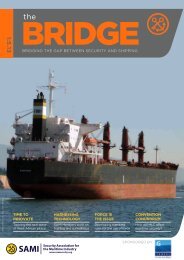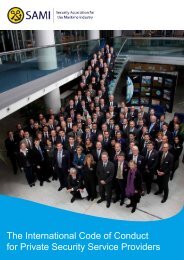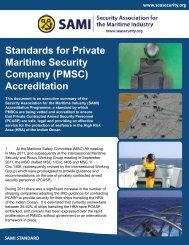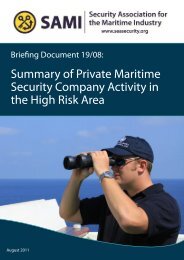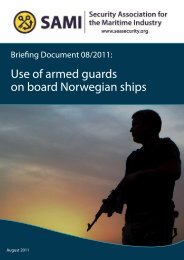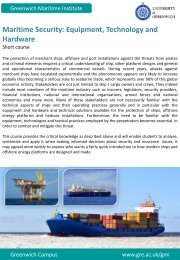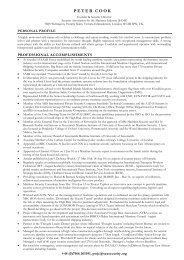SAMI Briefing Maritime Labour Convention FAQs and Text March 2013
SAMI Briefing Maritime Labour Convention FAQs and Text March 2013
SAMI Briefing Maritime Labour Convention FAQs and Text March 2013
You also want an ePaper? Increase the reach of your titles
YUMPU automatically turns print PDFs into web optimized ePapers that Google loves.
On ships flying the flags of countries that do not exercise effective jurisdiction <strong>and</strong>control over them, as required by international law, seafarers often have to work underunacceptable conditions, to the detriment of their well-being, health <strong>and</strong> safety <strong>and</strong> thesafety of the ships on which they work. Since seafarers' working lives are spent outside thehome country <strong>and</strong> their employers are also often not based in their country, effectiveinternational st<strong>and</strong>ards are necessary for this sector. Of course these st<strong>and</strong>ards must also beimplemented at a national level, particularly by governments that have a ship registry <strong>and</strong>authorize ships to fly their countries' flags (called “flag States”). This is already wellrecognized in connection with ensuring the safety <strong>and</strong> security of ships <strong>and</strong> protecting themarine environment. It is also important to underst<strong>and</strong> that there are many flag States <strong>and</strong>shipowners that take pride in providing the seafarers on their ships with decent conditionsof work. These countries <strong>and</strong> shipowners face unfair competition in that they pay the priceof being undercut by shipowners which operate subst<strong>and</strong>ard ships. The decision by theILO to move forward to create the maritime labour <strong>Convention</strong> was the result of a jointresolution in 2001 by the international seafarers' <strong>and</strong> shipowners' organizations, latersupported by governments. They pointed out that the shipping industry is “the world's firstgenuinely global industry” which “requires an international regulatory response of anappropriate kind – global st<strong>and</strong>ards applicable to the entire industry”. The industry calledon the ILO to develop “an instrument which brings together into a consolidated text asmuch of the existing body of ILO instruments as it proves possible to achieve” as a matterof priority “in order to improve the relevance of those st<strong>and</strong>ards to the needs of all thestakeholders of the maritime sector”. It was felt that the very large number of the existingmaritime <strong>Convention</strong>s, many of which are very detailed, made it difficult for governmentsto ratify <strong>and</strong> to enforce all of the existing international labour st<strong>and</strong>ards. Many of theexisting maritime labour <strong>Convention</strong>s were out of date <strong>and</strong> did not reflect contemporaryworking <strong>and</strong> living conditions on board ships. Many had low levels of ratification. Inaddition, there was a need to develop a more effective enforcement <strong>and</strong> compliance systemthat would help to eliminate subst<strong>and</strong>ard ships <strong>and</strong> that would work within the wellestablishedinternational system for enforcement of the international st<strong>and</strong>ards for shipsafety <strong>and</strong> security <strong>and</strong> environmental protection adopted in the framework of theInternational <strong>Maritime</strong> Organization (IMO). The MLC, 2006 was designed to specificallyaddress these concerns. More protection of seafarers will be achieved by the earlyratification <strong>and</strong> national level implementation of the new <strong>Convention</strong> by the vast majorityof ILO members active in the maritime sector.A2. What are the two basic aims of the MLC, 2006The basic aims of the MLC, 2006 are:— to ensure comprehensive worldwide protection of the rights of seafarers (the<strong>Convention</strong> is sometimes called the seafarers’ Bill of Rights);— to establish a level playing field for countries <strong>and</strong> shipowners committed to providingdecent working <strong>and</strong> living conditions for seafarers, protecting them from unfaircompetition on the part of subst<strong>and</strong>ard ships.A3. How will the MLC, 2006 protect more of the world's seafarers?In the first place, the MLC, 2006 is designed to achieve a higher level of ratificationthan previous <strong>Convention</strong>s [see A18. Why is the MLC, 2006 likely to achieve the aim ofnear universal ratification?] covering even seafarers working on ships that have not ratifiedthe <strong>Convention</strong> [see A4. What is meant by the “no more favorable treatment” clause?]. Itwill also cover all persons working at sea (now estimated at over 1.2 million). Until now ithad not been clear that all of these people, particularly for example, those that work onFAQ 3





